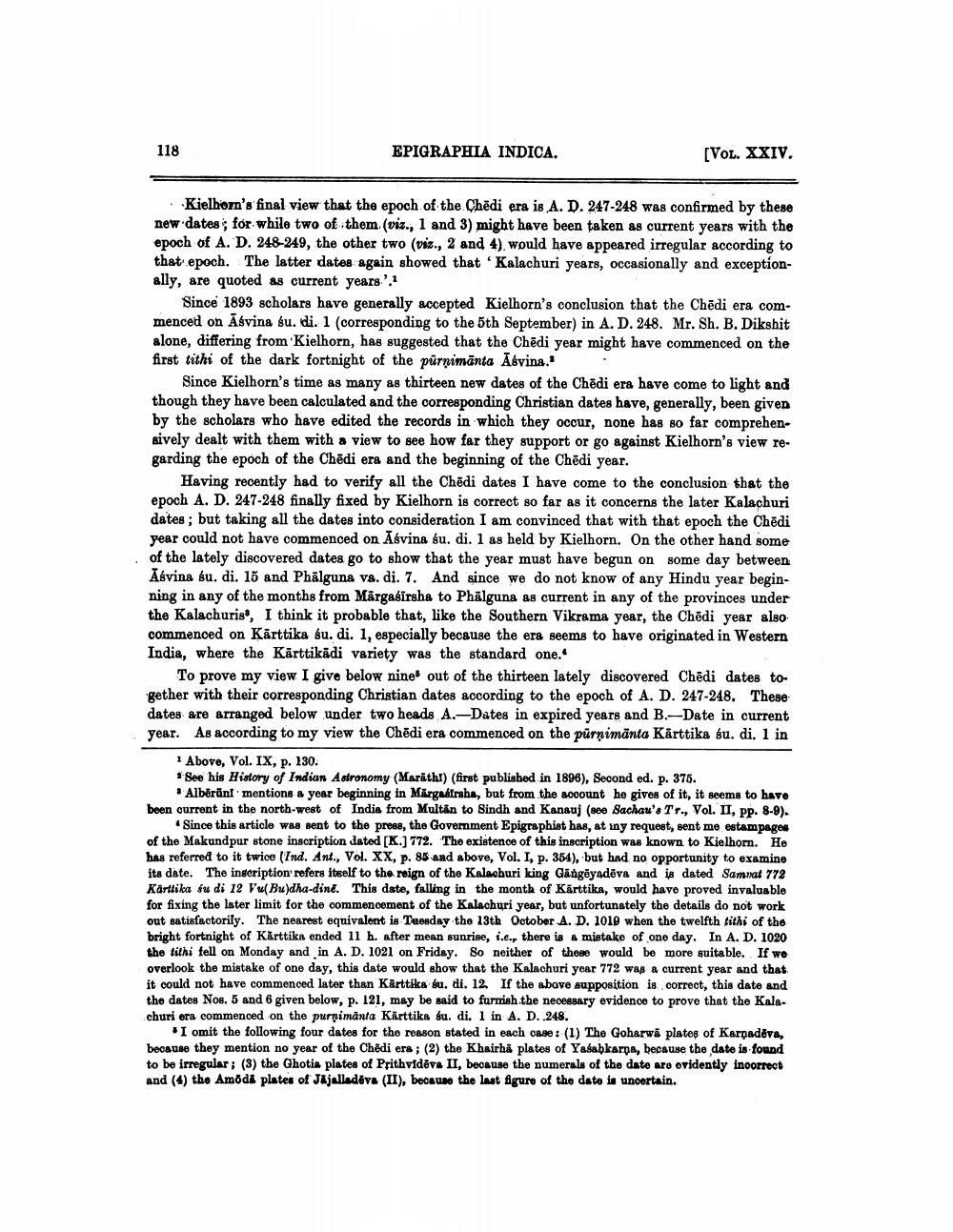________________
118
EPIGRAPHIA INDICA.
[VOL. XXIV.
Kielhor's final view that the epoch of the Chēdi era is A. D. 247-248 was confirmed by these new dates for while two of them (viz., 1 and 3) might have been taken as current years with the epoch of A. D. 248-249, the other two (viz., 2 and 4), would have appeared irregular according to that epoch. The latter dates again showed that 'Kalachuri years, occasionally and exceptionally, are quoted as current years'.1
Since 1893 scholars have generally accepted Kielhorn's conclusion that the Chēdi era commenced on Āsvina su. di. 1 (corresponding to the 5th September) in A. D. 248. Mr. Sh. B. Dikshit alone, differing from Kielhorn, has suggested that the Chēdi year might have commenced on the first tithi of the dark fortnight of the purnimānta Asvina.
Since Kielhorn's time as many as thirteen new dates of the Chedi era have come to light and though they have been calculated and the corresponding Christian dates have, generally, been given by the scholars who have edited the records in which they occur, none has so far comprehensively dealt with them with a view to see how far they support or go against Kielhorn's view regarding the epoch of the Chēdi era and the beginning of the Chēdi year.
Having recently had to verify all the Chēdi dates I have come to the conclusion that the epoch A. D. 247-248 finally fixed by Kielhorn is correct so far as it concerns the later Kalachuri dates; but taking all the dates into consideration I am convinced that with that epoch the Chēdi year could not have commenced on Asvina su. di. 1 as held by Kielhorn. On the other hand some of the lately discovered dates go to show that the year must have begun on some day between Asvina su. di. 17 and Phälguna va. di. 7. And since we do not know of any Hindu year beginning in any of the months from Märgasirsha to Phälguna as current in any of the provinces under the Kalachuris, I think it probable that, like the Southern Vikrama year, the Chodi year also commenced on Kärttika su. di. 1, especially because the era seems to have originated in Western India, where the Kärttikādi variety was the standard one.
To prove my view I give below nines out of the thirteen lately discovered Chēdi dates together with their corresponding Christian dates according to the epoch of A. D. 247-248. These dates are arranged below under two heads A.-Dates in expired years and B.-Date in current year. As according to my view the Chēdi era commenced on the pürnimänta Kärttika su. di. 1 in
1 Above, Vol. IX, p. 130. "See his History of Indian Astronomy (Marathi) (first published in 1896), Second ed. p. 375.
• Albērünf mentions a year beginning in Margastraha, but from the account he gives of it, it seems to have been current in the north-west of India from Multân to Sindh and Kanauj (see Sachau's Tr., Vol. II, pp. 8-9).
4 Since this article was sent to the press, the Government Epigraphist has, at any request, sent me estampage of the Makundpur stone inscription dated [K.) 772. The existence of this inscription was known to Kielhorn. He has referred to it twice (Ind. Ant., Vol. XX, p. 85 and above, Vol. I, p. 354), but had no opportunity to examine ita date. The inscription' refers itself to the reign of the Kalachuri king Gängeyadēva and is dated Samsal 772 Kartlika fu di 12 V (Buldha-dind. This date, falling in the month of Karttika, would have proved invaluable for fixing the later limit for the commencement of the Kalachuri year, but unfortunately the details do not work out satisfactorily. The nearest equivalent is Taesday the 13th October A. D. 1019 when the twelfth tithi of the bright fortnight of Kärttika ended 11 h. after mean sunrise, i.e., there is a mistake of one day. In A. D. 1020 the tithi fell on Monday and in A. D. 1021 on Friday. So neither of these would be more suitable. If we overlook the mistake of one day, this date would show that the Kalachuri year 772 was a current year and that it could not have commenced later than Karttika su. di. 12 If the above supposition is correct, this date and the dates Nos. 5 and 6 given below, p. 121, may be said to furmish the necessary evidence to prove that the Kala. churi era commenced on the purnimanta Kärttika su. di. 1 in A. D. 248.
I omit the following four dates for the reason stated in each case: (1) The Goharwā plates of Karpadova, because they mention no year of the Chēdi era ; (2) the Khairhå plates of Yasabkarpa, because the date is found to be irregular; (3) the Ghotia plates of Prithvidēva II, because the numerals of the dato aro ovidently incorrect and (4) the Amoda plates of Jajallodova (II), because the last figure of the date is unoertain.




